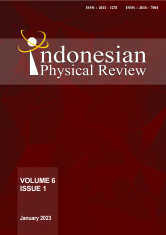THE EFFECTS OF DISTILLATION TEMPERATURE AND PLASTIC LOADING ON THE IMPROVEMENT OF WASTE-DERIVED BIO-OIL PROPERTIES
DOI:
10.29303/ipr.v6i1.200Downloads
Abstract
Since plastic and food waste are both types of non-lignocellulosic biomass, these must be handled and managed correctly to avoid pollution problems and damage to the environment. Bio-oil, made from recycled materials, including plastic and food waste, is one focus of these attempts. The co-pyrolysis method is being investigated in this study as a technique of recycling plastic waste and food waste to produce biofuels with reduced environmental impact. In terms of energy efficiency, bio-oil is unequal to other fuels like coal or natural gas because of its high acidity, high oxygen content, and low thermal stability. Therefore, a vacuum distillation process is required to improve bio-oil quality by adjusting the distillation temperature from 300 to 350 OC and the percentage of plastic waste used from 30 to 50%. The bio-oil was analyzed using a Gas Chromatography-Mass Spectrometer (GC-MS). The general compound showed that acids (60%) and alcohols (20%) were the most prevalent chemical compounds, followed by phenol (4%), aldehyde (14%), aliphatic (5%), Furan (14%), and ketones (11%) at maximum temperature (350 oC) for 30-50% plastic waste. Meanwhile, the final product is affected by temperature and plastic waste (PET) ratio factors. At 350 °C and a plastic waste addition of 50%, the highest bio-oil yield is 45%.
Keywords:
Bio-oil; Distillation; Temperature; Upgrading; Plastic loadingReferences
S. Jenderal, D. E. Nasional, K. E. Dan, and S. D. Mineral, “RENCANA STRATEGIS 2015 s.d. 2019,†2014.
S. Summers, S. Yang, J. Watson, and Y. Zhang, “Diesel blends produced via emulsification of hydrothermal liquefaction biocrude from food waste,†Fuel, vol. 324, no. PC, p. 124817, 2022, doi: 10.1016/j.fuel.2022.124817.
R. T. Terms, “NRC Publications Archive Archives des publications du CNRC Thermal decomposition products of polyacrylonitrile THERMAL DECOMPOSITION PRODUCTS,†1977.
R. Aprian and A. Munawar, “Pengolahan Sampah Plastik Menjadi Minyak Menggunakan Proses Pirolisis,†Envirotek : Jurnal Ilmiah Teknik Lingkungan, vol. 4, no. 1, pp. 44–53, 2012.
X. Wang et al., “Coke formation and its impacts during electrochemical upgrading of bio-oil,†Fuel, vol. 306, no. June, p. 121664, 2021, doi: 10.1016/j.fuel.2021.121664.
Y. He, R. Liu, D. Yellezuome, W. Peng, and M. Tabatabaei, “Upgrading of biomass-derived bio-oil via catalytic hydrogenation with Rh and Pd catalysts,†Renewable Energy, vol. 184, pp. 487–497, 2022, doi: 10.1016/j.renene.2021.11.114.
N. Chaihad et al., “In-situ catalytic upgrading of bio-oil from rapid pyrolysis of biomass over hollow HZSM-5 with mesoporous shell,†Bioresource Technology, vol. 341, no. September, p. 125874, 2021, doi: 10.1016/j.biortech.2021.125874.
H. A. Baloch et al., “Catalytic upgradation of bio-oil over metal supported activated carbon catalysts in sub-supercritical ethanol,†Journal of Environmental Chemical Engineering, vol. 9, no. 2, p. 105059, 2021, doi: 10.1016/j.jece.2021.105059.
H. Nam, J. Choi, and S. C. Capareda, “Comparative study of vacuum and fractional distillation using pyrolytic microalgae (Nannochloropsis oculata) bio-oil,†Algal Research, vol. 17, pp. 87–96, 2016, doi: 10.1016/j.algal.2016.04.020.
A. Amrullah and M. Rifky, “Upgrading of slow pyrolysis Eleocharis Dulcis bio-oils through vacuum distillation,†Materials Today: Proceedings, vol. 63, pp. S287–S292, 2022, doi: 10.1016/j.matpr.2022.02.494.
A. Amrullah, O. Farobie, S. Septarini, and J. A. Satrio, “Synergetic biofuel production from co-pyrolysis of food and plastic waste: reaction kinetics and product behavior,†Heliyon, vol. 8, no. 8, p. e10278, 2022, doi: 10.1016/j.heliyon.2022.e10278.
A. Amrullah, O. Farobie, and R. Widyanto, “Pyrolysis of purun tikus (Eleocharis dulcis): Product distributions and reaction kinetics,†Bioresource Technology Reports, vol. 13, no. February, p. 100642, 2021, doi: 10.1016/j.biteb.2021.100642.
Y. Kobayashi et al., “Experimental investigation on the effect of electron injection into air for thermal decomposition of solid waste,†Applied Energy, vol. 295, no. March 2020, p. 116999, 2021, doi: 10.1016/j.apenergy.2021.116999.
L. Nazari, Z. Yuan, S. Souzanchi, M. B. Ray, and C. Xu, “Hydrothermal liquefaction of woody biomass in hot-compressed water: Catalyst screening and comprehensive characterization of bio-crude oils,†Fuel, vol. 162, pp. 74–83, 2015, doi: 10.1016/j.fuel.2015.08.055.
R. Kumar Mishra and K. Mohanty, “Co-pyrolysis of waste biomass and waste plastics (polystyrene and waste nitrile gloves) into renewable fuel and value-added chemicals,†Carbon Resources Conversion, vol. 3, no. October, pp. 145–155, 2020, doi: 10.1016/j.crcon.2020.11.001.
Z. Wang, K. G. Burra, T. Lei, and A. K. Gupta, “Co-pyrolysis of waste plastic and solid biomass for synergistic production of biofuels and chemicals-A review,†Progress in Energy and Combustion Science, vol. 84, p. 100899, 2021, doi: 10.1016/j.pecs.2020.100899.
D. Mohan, C. U. Pittman, and P. H. Steele, “Pyrolysis of wood/biomass for bio-oil: A critical review,†Energy and Fuels, vol. 20, no. 3, pp. 848–889, 2006, doi: 10.1021/ef0502397.
License

This work is licensed under a Creative Commons Attribution-NonCommercial-ShareAlike 4.0 International License.
Authors who publish with Indonesian Physical Review Journal, agree to the following terms:
- Authors retain copyright and grant the journal right of first publication with the work simultaneously licensed under a Creative Commons Attribution-ShareAlike 4.0 International Licence (CC BY SA-4.0). This license allows authors to use all articles, data sets, graphics, and appendices in data mining applications, search engines, web sites, blogs, and other platforms by providing an appropriate reference. The journal allows the author(s) to hold the copyright without restrictions and will retain publishing rights without restrictions.
- Authors are able to enter into separate, additional contractual arrangements for the non-exclusive distribution of the journal's published version of the work (e.g., post it to an institutional repository or publish it in a book), with an acknowledgment of its initial publication in Indonesian Physical Review Journal.
- Authors are permitted and encouraged to post their work online (e.g., in institutional repositories or on their website) prior to and during the submission process, as it can lead to productive exchanges, as well as earlier and greater citation of published work (See The Effect of Open Access).





